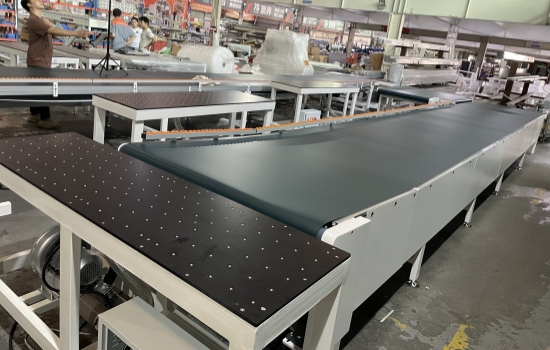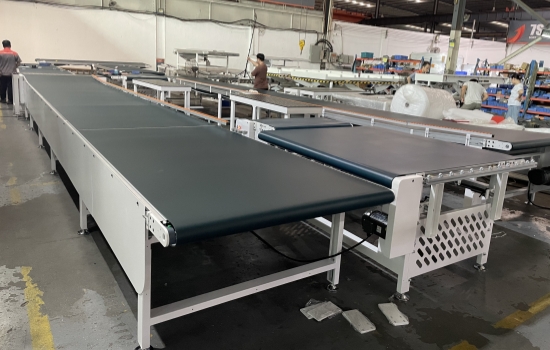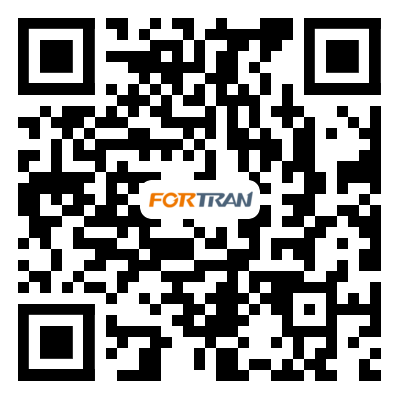
- English
- Español
- Português
- русский
- Français
- 日本語
- Deutsch
- tiếng Việt
- Italiano
- Nederlands
- ภาษาไทย
- Polski
- 한국어
- Svenska
- magyar
- Malay
- বাংলা ভাষার
- Dansk
- Suomi
- हिन्दी
- Pilipino
- Türkçe
- Gaeilge
- العربية
- Indonesia
- Norsk
- تمل
- český
- ελληνικά
- український
- Javanese
- فارسی
- தமிழ்
- తెలుగు
- नेपाली
- Burmese
- български
- ລາວ
- Latine
- Қазақша
- Euskal
- Azərbaycan
- Slovenský jazyk
- Македонски
- Lietuvos
- Eesti Keel
- Română
- Slovenski
- मराठी
- Srpski језик
Edge Banding Machine Belt Return Line: The Automated "Circulation Hub" for Panel Furniture Edge Banding Processes
2025-10-09
The edge banding machine belt return line is an automated conveying device specifically designed to work with edge banding machines. It uses a belt as its core conveying medium and employs a "circular return" structure to enable automatic direction changing, conveying,
and secondary loading of panels after edge banding.
This device completely replaces the traditional manual panel handling method, serving as a key component to connect edge banding processes and improve production efficiency. It is widely used in large-scale processing scenarios such as whole-house customization and furniture production.


Core Functions: Addressing "Efficiency and Labor" Pain Points in Edge Banding Processes
1. Automated Circular Conveying:
After an edge banding machine finishes single-edge banding of a panel, the belt return line can directly convey the panel to the direction-changing mechanism without manual handling.
The panel is then automatically returned to the feeding end of the edge banding machine, forming a closed-loop operation of "edge banding → return → re-edge banding".
A single worker can operate one edge banding machine to complete multi-edge banding, reducing labor costs by over 60%.
2. Stable Panel Protection:
Wear-resistant and non-slip belts (e.g., PU material) are used as the conveying medium. Combined with pressure rollers and guide baffles, the panels are evenly stressed and run stably during conveying.
This prevents edge collisions and surface scratches caused by manual handling, making it particularly suitable for fragile surfaces such as PET door panels and skin-feel film panels.
3. Flexible Adaptation to Production Needs:
It supports speed adjustment from 0 to 1000 mm/min, which can be accurately matched to the processing rhythm of the edge banding machine.
Through modular design, it can adapt to panels with a thickness of 3-50 mm and a maximum size of 2.4m × 1.2m.
Additionally, it can be customized into "U-shaped", "L-shaped", and other layouts to fit different workshop spaces.
4. Connection to Automated Production Lines:
It can be linked with multiple edge banding machines, CNC machining centers, or automatic loading machines to form a fully automated production line covering "panel cutting → edge banding → drilling".
Some high-end models support connection to MES systems, enabling real-time monitoring of conveying speed and panel quantity for easier production manageme.
Application Scenarios: Focusing on Core Needs of "Multi-Edge Banding"
The application of the belt return line is highly concentrated in processing scenarios requiring multi-edge banding, making it an "essential equipment" for furniture production:
1. Multi-Edge Banding with a Single Edge Banding Machine:
When used with a fully automatic edge banding machine to complete 2-4 edge banding processes for panels (e.g., four-edge banding for cabinet side panels),
the panel is returned by the belt return line after the first edge banding. Workers only need to adjust the panel direction to start the second edge banding, with no manual handling required throughout the process.
2. Automated Production with Multi-Equipment Linkage:
In high-end factories, it connects two edge banding machines to form a "dual-machine line" — one machine is responsible for edge banding the long sides of panels,
and the other for the short sides. The belt return line undertakes intermediate transfer, enabling unmanned processing of "one-time loading, four-edge banding".
3. Efficient Conveying of Large-Size Panels:
For large-size panels such as wardrobe door panels and TV cabinet panels, the coordinated conveying of multiple belts prevents the panels from sagging and deforming.
Combined with slope conveying sections and auxiliary rollers, it ensures stable return of large panels without damage.


